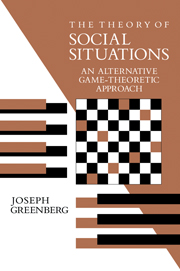Book contents
- Frontmatter
- Contents
- Preface
- 1 Overview
- 2 The theory of social situations
- 3 Examples
- 4 Abstract stable sets
- 5 Existence and uniqueness of OSSB and CSSB
- 6 Characteristic function form games
- 7 Normal form games
- 8 Extensive form games with perfect information
- 9 Infinitely repeated games
- 10 Implementation by means of situations
- 11 Closing remarks
- References
- Index
5 - Existence and uniqueness of OSSB and CSSB
Published online by Cambridge University Press: 05 June 2012
- Frontmatter
- Contents
- Preface
- 1 Overview
- 2 The theory of social situations
- 3 Examples
- 4 Abstract stable sets
- 5 Existence and uniqueness of OSSB and CSSB
- 6 Characteristic function form games
- 7 Normal form games
- 8 Extensive form games with perfect information
- 9 Infinitely repeated games
- 10 Implementation by means of situations
- 11 Closing remarks
- References
- Index
Summary
This chapter establishes existence and uniqueness results that will be used extensively in the applications of the theory of social situations in Chapters 6–10. Thus, this chapter is rather technical. The reader may proceed directly to the next chapters and accept statements that refer to this chapter. Alternatively, the reader may wish to familiarize himself (at least in the first reading) only with the definitions and results of this chapter but skip the proofs.
Hierarchical situations
Interesting social environments are frequently represented by situations said to be “hierarchical,” which have a relatively simple structure. For example, the situation in Example 2.1.2, the voting by veto model in Example 3.6, and games in characteristic function, normal, and extensive form (see Chapters 6–10) are naturally associated with hierarchical situations.
An important property of many hierarchical situations is that they admit a unique OSSB and a unique CSSB. Moreover, these two notions can be derived explicitly by the (recursive) formulas that fully characterize them (see Theorems 5.2.1 and 5.4.1).
A situation (γ,Γ) is hierarchical if there exists a finite “hierarchy” of the positions in Γ such that a position can be induced either from positions of a higher hierarchy than it or else from itself. Moreover, for every G∈Γ, there is at most one coalition, denoted S(G), that can induce G from itself.
Before stating the formal definition, it should be stressed that the hierarchical structure is only a technical construct that carries no other meaning or interpretation whatsoever.
- Type
- Chapter
- Information
- The Theory of Social SituationsAn Alternative Game-Theoretic Approach, pp. 43 - 61Publisher: Cambridge University PressPrint publication year: 1990



